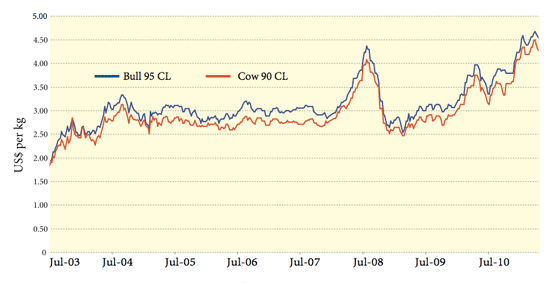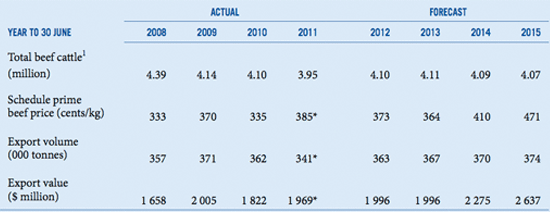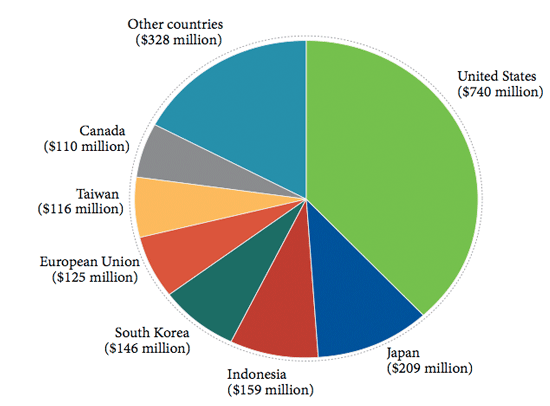



MAF New Zealand Beef Outlook
International prices of beef rose sharply in the last half of 2010 and early 2011, owing to falling global production and export availability and increasing demand. New Zealand meat production in the year to 30 June 2011 has been reduced by adverse weather in the second half of 2010. Assuming normal climatic conditions, production is expected to recover in the next season; however, beyond 2012 land use change to dairy will constrain production, reports the NZ Ministry of Agriculture. Prices for New Zealand’s manufacturing beef in the US reached record highs in early April 2011. Increasing prices from late 2009 reflected the recovery from the global financial crisis, droughts in several beef-producing countries, and higher feed costs in the US.
US domestic beef prices have lifted as the country’s beef production and imports have fallen and exports increased. Large-scale beef feedlot operations have had to reduce production and cattle numbers, which has effectively passed on the sharp rises in grain input prices. At 1 January 2011, US cattle inventory numbers had fallen 1.4 percent, to their lowest level since 1958.
Prices for New Zealand’s manufacturing beef in the US – the predominant cut of beef in New Zealand’s exports to the US – have risen relative to premium cuts of beef. This is due to price-conscious consumers trading down to ground beef and lower import volumes from Australia and New Zealand. Supply constraints are likely to improve as herd rebuilding takes place in the US and Australia over the next few years, and beef production increases in developing countries, especially in South America. Consequently,
Figure 14.1: In-Market Prices Of Manufactured New Zealand Beef In The US

New Zealand beef export prices, in US dollars, are expected to fall slowly over the next two years. Further out, growing incomes and population in Asian and other developing countries, along with increasing production, mostly in developing countries, should result in rising prices as supply lags behind demand.
Beef schedules in New Zealand are expected to be at record levels for the year ending 30 June 2011, reflecting the impact of high international prices. The prime steer and heifer schedule over the 2012 to 2015 years is forecast to average over 400 cents per kilogram, up on the 340 cents per kilogram average for 2007 to 2010. The forecast is strongly influenced by an assumed depreciation of the New Zealand dollar from the 2012 September quarter.
Production
Total beef production in the year ending 30 June 2011 is estimated to be down 9.0 percent because of lower total cattle numbers at 30 June 2010 and lower carcass weights resulting from adverse climate up to early January 2010. Over the outlook period, total production is projected to steadily increase thanks to a rising number of cull cows from a growing national dairy herd and a slow increase in average beef carcass weights.
Table 14.1: Beef Cattle Numbers, Beef Prices And Export Volumes And Values, 2008–2015

1. Opening numbers are as at 30 June of the preceding year.
Symbol
* Estimate
Sources: Beef + Lamb New Zealand Limited Economic Service, Statistics New Zealand and MAF.
The Agricultural Production Statistics at 30 June 2010 showed total beef cattle numbers down 3.7 percent to 3.95 million, while the beef breeding herd was up 2.0 percent. A recovery in non-breeding beef numbers is expected over the next two years, while further out a slow decline is projected as dairy and dairy grazing activities continue to expand.
Exports
Total beef export value for the year ending 30 June 2011 is estimated to be up 8.1 percent to $2.0 billion, reflecting the net impact of a 15 percent increase in price and a 5.8 percent fall in volume. By 2015, beef export value is projected to increase to $2.6 billion, reflecting increased production and an assumed exchange rate depreciation in later years.
The US is New Zealand’s main beef market. For the year ended 31 December 2010, the US received 43 percent of total beef export volume and accounted for 38 percent of beef export value. New Zealand’s beef market access in the US is subject to a tariff rate quota of 213 402 tonnes of product weight. For the year ended December 2010, New Zealand’s quota fill was down to 69 percent, as higher volumes went to Indonesia, Japan, Philippines, South Korea, Saudi Arabia and Russia.
Figure 14.2: Beef Exporting Destinations By Value, Year Ended 31 December 2010



